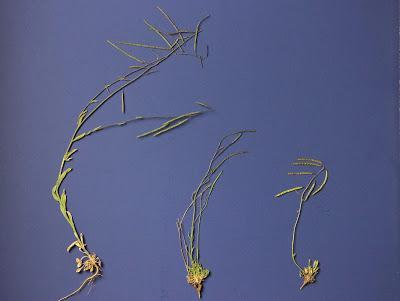
The lineup.
At the southern end of the Wind River Mountains near South Pass—where thousands of travelers on the old Oregon Trail crossed the Continental Divide “with no toilsome ascents”—granite mounds rise above rolling sagebrush grassland like irregular lumps of clay. This is a great place to hang out if you like to conjure up the far distant past, for they mark the southwest edge of North America 2.5 billion years ago.

Late Archean South Pass granite; botanist (center) and field assistant (lower right) for scale.
But that wasn’t why I was wandering around these outcrops … slowly walking, walking, walking ... staring at the ground. I was searching for plants that grow nowhere else in the world. One has to look hard to find them. They’re inconspicuous, small, drab, and have no flowers this time of year. Not that flowers would help—they’re also inconspicuous, small, and drab.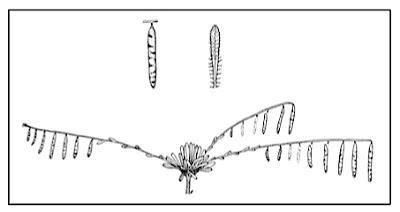
The South Pass rockcress (aka small rockcress), about 10 cm tall; drawing by Isobel Nichols (source).
Thirty years ago, the South Pass rockcress (Boechera pusilla) was one of the targets in my first rare plant survey project. It was known from a a single location, which was only vaguely specified: “in cracks and crevices of huge metamorphosed [actually igneous] rocks off Wyoming State Highway 28, 39 miles southwest of Lander,” collected in 1981.Boechera is part of the mustard family (Brassicaceae). It’s a large genus of subtly-different species—109 in North America, and at least 25 in Wyoming (experts disagree on classification). The group is thought to be an actively-evolving group (source), which may explain why rockcresses are tough to identify, and why field botanists are happy to ignore them. But I couldn't.The flowers are small, with little variation among species, so we depend on mature fruit—siliques—for identification. Those of the South Pass rockcress are relatively broad (to 2 mm) and arch downwards but not sharply so.
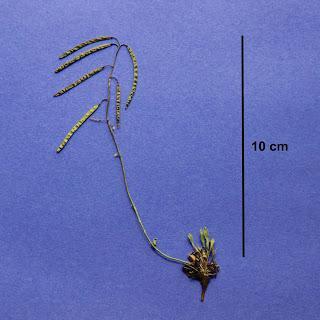
Boechera pusilla, with spreading-descending relatively-broad siliques (seed pods).
One also has to examine the hairs on the basal leaves, visible with a 10x hand lens (click on images below to enlarge). Are they sparse, and simple to few-branched (South Pass rockcress)? Or are they dense, and branched multiple times (other species in the area)?
Sparse simple-or-forked hairs on basal leaves of Boechera pusilla.
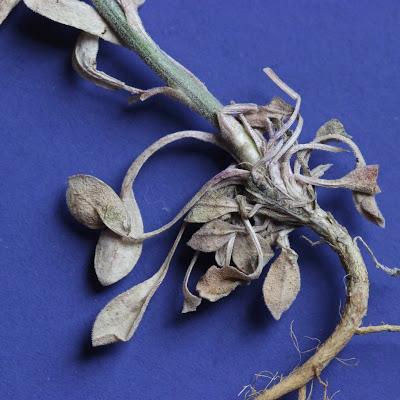
Dense fine dendritic hairs on basal leaves of Boechera pendulocarpa (dropseed rockcress).
These are tough decisions but unavoidable because at least four other rockcresses grow in the South Pass area. Some of them hybridize, making intermediates. It’s a mess.[Boechera used to be part of Arabis] “The taxonomic complexity of Arabis, in the broad sense, is legendary … most of the problematic taxa come to reside in Boechera. A rare confluence of hybridization, apomixis, and polyploidy makes this one of the most difficult genera in the North American flora [emphasis added] (source).Maybe you can imagine the agony of a young field botanist trying to find this rare rockcress among common ones. My strategy was to collect specimens of all the different rockcresses I found, from multiple locations, and then send them to the late Reed Rollins at Harvard University, the expert for the group. It was Rollins who collected the specimen from “huge metamorphosed rocks” in 1981. My collections came back from Harvard with only one labeled Boechera pusilla, the South Pass rockcress. Was it from the same location as Rollins’s 1981 specimen? We’ll never know, but in any case, this rockcress was obviously rare.
In fact, it's rare enough to be a Category 1 candidate for Federal listing under the Endangered Species Act. To avoid listing, the Bureau of Land Management has taken steps to protect it, including closing a four-wheel-drive road to the site, and funding regular monitoring.
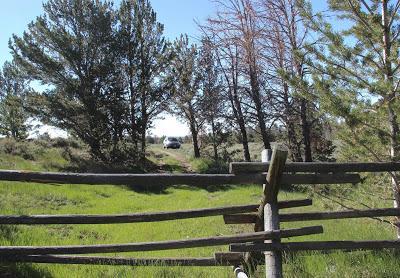
We don't mind that we now have to walk to see the South Pass rockcress!
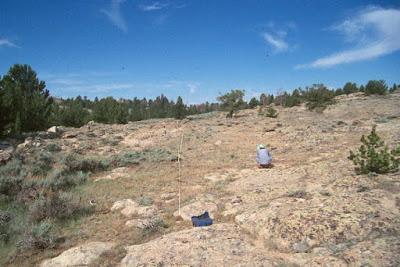
Yours truly, counting South Pass rockcress plants in 1988, the first year of monitoring. WYNDD.
I returned to the single known South Pass rockcress site this year, to help with monitoring. Now I have 30 years of experience searching for rare plants, many of which are difficult to distinguish from common relatives (why is that?—another of life’s unanswered questions). It was a lot easier to recognize our target. After examining the various rockcresses at the site, I was comfortable making identifications in the field. A cheat sheet helped: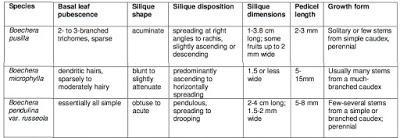
Modified from Heidel 2005.
The first step in a rare plant survey involves visiting known sites to develop a search image for the target species—a pattern that will really grab your attention. In this case it was the small cluster of green leaves below one or several stems with dangling siliques (pods). If I spotted such a cluster, I then glanced at the width and position of the siliques (relatively broad, spreading or descending). Finally I got down at plant level with my hand lens, and looked for the distinctive hairs on the basal leaves.Armed with this search image, I went hunting. At the single known site, the South Pass rockcress grows at the base of a large outcrop of South Pass granite, in low rocky habitat with pockets of gravely soil, pretty much at ground-level (see monitoring photo above). I drove around until I found similar sites, and then slowly criss-crossed potential habitat, eyes glued to the ground. At the third site, I was stopped dead in my tracks by a cluster of green leaves below dangling siliques. The hairs on the basal leaves confirmed it—this was a new location for the South Pass rockcress!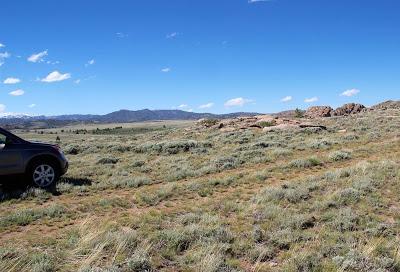
South Pass rockcress grows among low rocks mid photo; main outcrop visible behind on right.

Microhabitat is gravely soil in pockets and crevices.
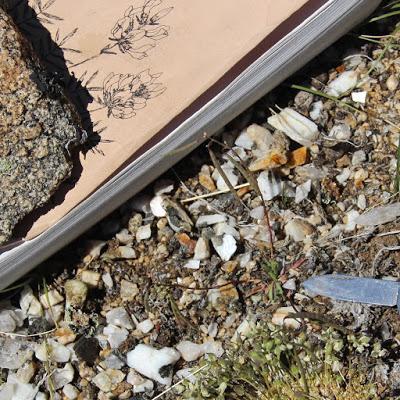
At knife-tip: cluster of green basal leaves, and three stems with drooping siliques. Not a photogenic plant!
Now the hard question—how much more is out there? How rare is the South Pass rockcress? There are many similar outcrops in the South Pass area … yet I had come up with only one specimen in all my collecting in 1986 … yet I didn’t really know what I was looking for then … and is it really restricted to just South Pass granite??! Obviously more work is needed.The new site is exciting, but also discouraging. The population is really small, and with widely-scattered individual plants. Three of us, botanists all, went back two days later and it took us 15 minutes to find a plant. In all, we found only 11 after a thorough search of about 0.25 ha (half an acre). If this little rockcress sometimes (or often?) grows in small sparse populations, survey will be tough indeed.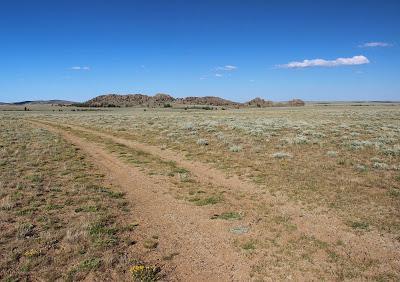
Potential habitat: South Pass granite above rolling sagebrush grassland.
Finally, for the taxonomy geeks among us: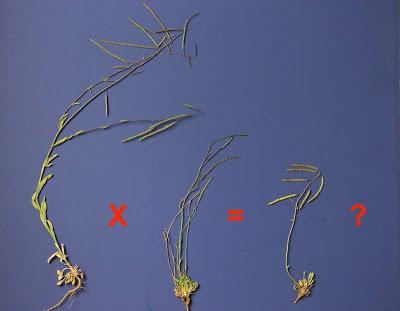
L to R: Boechera pendulocarpa, B. microphylla, B. pusilla.
Might the South Pass rockcress be a recently-evolved hybrid, rare because it hasn’t had time to disperse far? We know it’s an allotriploid (two sets of chromosomes from one parent, one from the other). Could it be the offspring of occasional crossing between the littleleaf and dropseed rockcresses? They’re common at both known sites, and …“The sexual diploid species are relatively distinct from one another, but they hybridize wherever they come into contact [italics added]. Through apomixis and polyploidy, the hybrids become stable, self-propagating lineages. … for any pair of sexual diploid species (e.g., AA and BB), this process can yield different intermediates, including AB apomicts and both possible apomictic triploids (AAB and ABB). … Under these circumstances, even the most distinctive sexual diploid progenitors can become lost in a seemingly continuous range of morphological variability” (source).

Sources
Al-Shehbaz, IA, and Windham, MD. Boechera in the Flora of North America. http://www.efloras.org/florataxon.aspx?flora_id=1&taxon_id=104152&key_no=2 (accessed 27 June 2016).Heidel, B. 2005. Status of Boechera pusilla (small rockcress) in Wyoming. Prepared for the Bureau of Land Management. Wyoming Natural Diversity Database, Laramie, WY. https://www.uwyo.edu/wyndd/_files/docs/reports/wynddreports/u05hei06wyus.pdf
Marriott, H.J. 1986. A report on the status of Arabis pusilla, a Candidate Threatened species. Prepared for the US Fish and Wildlife Service by the Wyoming Natural Diversity Database, Laramie, WY. Available here upon request.
